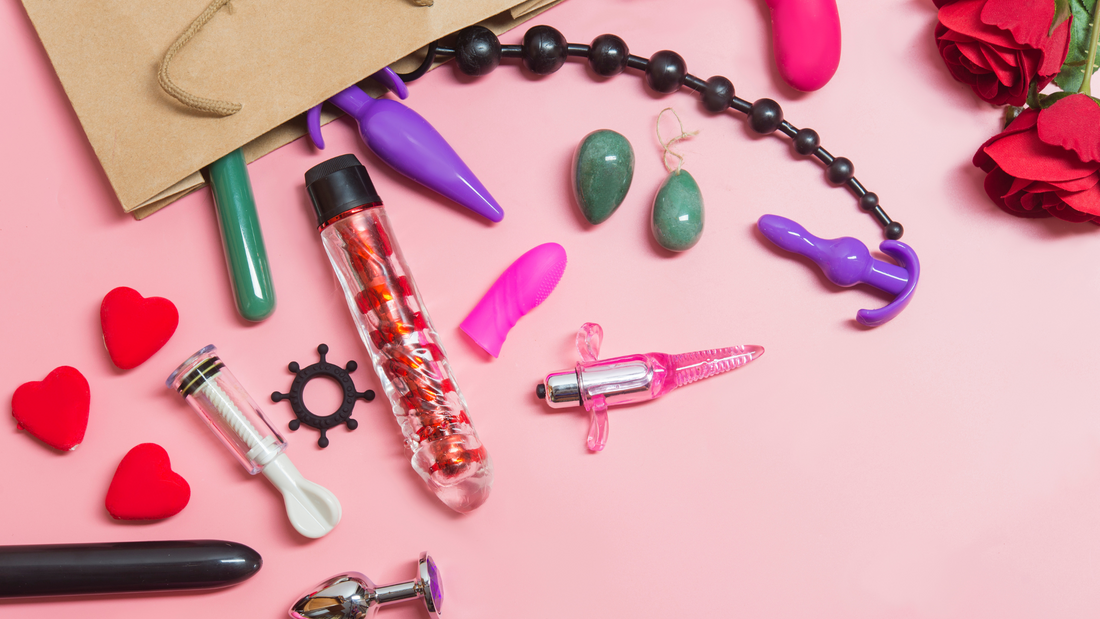
Sex Toy Materials Explained
Share
Why Material Matters More Than You Think
When it comes to choosing a sex toy, it’s easy to focus on features like size, shape, and vibration settings. But one of the most important — and often overlooked — factors is the material it’s made from.The material of a sex toy affects safety, hygiene, sensation, and overall durability. Whether you’re a complete beginner or upgrading your collection, understanding toy materials helps you make smarter, safer, and more satisfying choices.In this guide, we’ll explain the most common sex toy materials, what they’re best for, and what to avoid.
Why Sex Toy Material Is So Important
Choosing the right material isn't just about feel — it's about protecting your body. Here's why material matters:
- Body safety: Some materials are non-porous and hypoallergenic, while others can harbour bacteria or irritate sensitive skin.
- Ease of cleaning: Non-porous toys are far easier to clean and keep hygienic.
- Longevity: Higher-quality materials last longer and are less likely to degrade or become sticky over time.
- Lubricant compatibility: Certain materials only work safely with specific types of lube (e.g. silicone toys need water-based lubricant).
Let’s break down the most common options.
The Most Common Sex Toy Materials Explained
1. Medical-Grade Silicone 🟢 Highly Recommended
Safe, soft, and silky — silicone is the gold standard for most modern sex toys.
- Body-safe and hypoallergenic
- Non-porous (won’t absorb bacteria or fluids)
- Velvety smooth or firm finishes available
- Easy to clean with warm water and mild soap
- Compatible with water-based lubricants only
You’ll find silicone used in a wide range of toys — from rabbit vibrators to butt plugs and clit stimulators.🟢 Best for: Most users, especially if you value safety and comfort
🔴 Avoid: Using silicone lube with silicone toys (can degrade the material)
2. ABS Plastic 🟢 Safe and Versatile
ABS plastic is hard, smooth, and body-safe — often used in bullet vibes and toy handles.
- Non-porous and hygienic
- Firm texture — great for precision stimulation
- Usually combined with other materials (e.g. silicone tips)
- Often used in entry-level vibrators and remote controls
🟢 Best for: Bullet vibrators, beginner-friendly toys
🔴 Avoid: Dropping — it can crack more easily than silicone
3. Stainless Steel & Aluminium 🟢 Luxury and Weighty
Smooth, solid, and elegant, metal toys offer intense sensations and temperature play.
- Non-porous and body-safe
- Compatible with any lubricant (including silicone and oil-based)
- Can be warmed or cooled for extra stimulation
- Heavier, which adds pressure and fullness
🟢 Best for: Experienced users, G-spot or prostate toys, those who enjoy temperature play
🔴 Avoid: Dropping (can damage hard surfaces — not the toy!)
4. Glass (Borosilicate/Pyrex) 🟢 Elegant and Firm
Body-safe glass toys are beautiful, smooth, and perfect for those who like firmer sensations.
- Non-porous and hypoallergenic
- Works with all lubricants
- Great for temperature play (heat or chill in water)
- Rigid and can be textured or smooth
🟢 Best for: G-spot stimulation, anal play (with flared base), fans of firmness
🔴 Avoid: Knocking against hard surfaces — even borosilicate can chip if mishandled
5. TPE / TPR (Thermoplastic Elastomers/Rubber) 🔶 Use With Caution
These materials are soft and flexible, but usually porous and not 100% body-safe.
- Often used in cheaper toys or strokers
- Porous — can harbour bacteria even after cleaning
- Feels realistic but degrades over time
🟠 Best for: Temporary or novelty use, budget-conscious buyers
🔴 Avoid: Sharing or long-term use; always use condoms over porous toys
6. Jelly or “Love Gel” Toys 🔴 Not Recommended
These toys are often brightly coloured, cheap, and widely sold — but they’re usually made from low-grade PVC or rubber.
- Often contain phthalates (a chemical linked to health risks)
- Highly porous — cannot be cleaned effectively
- May smell of chemicals or become sticky with time
🔴 Best for: Honestly? Avoid altogether.
✅ If you already own one: Use a condom over it and don’t share it.
Quick Comparison: Sex Toy Material Safety Table
| Material | Body-Safe? | Porous? | Lube Compatibility | Cleaning |
| Silicone | ✅ Yes | ❌ No | Water-based only | Warm water + soap |
| ABS Plastic | ✅ Yes | ❌ No | All lubes (check label) | Warm water + soap |
| Stainless Steel | ✅ Yes | ❌ No | All lubes | Boil or wipe clean |
| Borosilicate Glass | ✅ Yes | ❌ No | All lubes | Boil or wipe clean |
| TPE/TPR | ⚠️ Semi-safe | ✅ Yes | Water-based preferred | Use condom + clean well |
| Jelly/PVC | ❌ No | ✅ Yes | Water-based only (if used) | Not recommended |
Final Thoughts: Always Put Safety First
The most pleasurable toy is one that’s safe, clean, and comfortable for your body. Investing in body-safe materials like silicone, glass, or stainless steel ensures you can focus on enjoying your toy — not worrying about irritation, infection, or harmful chemicals.When in doubt, check the product description. Reputable retailers (like us!) clearly list the materials used, and we always prioritise body-safe designs.✨ Looking for body-safe sex toys?
Explore our full collection of Silicone Sex Toys, Metal Toys, or Beginners’ Favourites today.